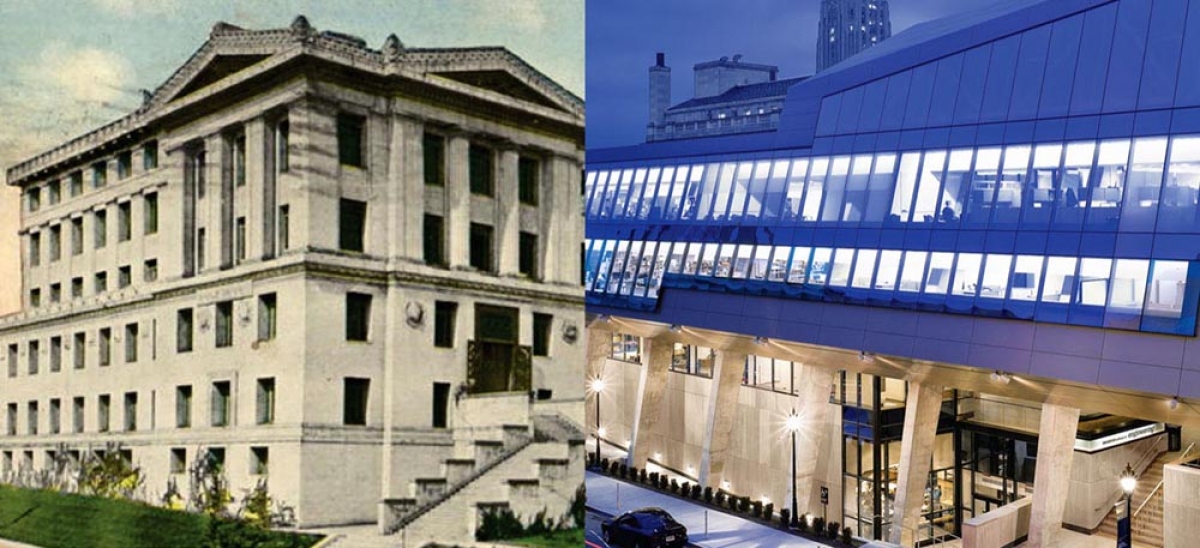Engineering the Future at Pitt

It was the early 1960s, and it was a different time, recalls John “Jack” Mascaro. Like many of his fellow baby boomers, the young student showed up to his engineering classes at the University of Pittsburgh sporting a sweater and a tie, while his professors wore suits. It was a time when engineering students were in growing demand—the American economy was on the rise, the Cold War threatened nuclear disaster and President Kennedy urgently called to put a man on the moon.
A little over 40 years later, Mascaro walked the grounds of his alma mater again, where he earned both his bachelor’s and master’s degrees in civil engineering. Things had changed, and not just in students’ clothing choices. The worst financial crisis since the Great Depression had just hit, sending the global economy into a recession. Since the early ’60s, the world’s population had doubled, and climate change and fossil-fuel dependence cast a dark shadow on the near future, as then presidential hopeful Barack Obama called to cut carbon emissions by a drastic 80 percent by 2050.
For engineers, such as Mascaro, the demand to find innovative solutions was clear, whether in energy sources that power our vehicles, buildings and infrastructure that make up our growing cities, biomedical technology that saves our lives, or the computers that control our systems. And the numbers seemed to agree—STEM (science, technology, engineering, mathematics) jobs had been growing three times as fast as other jobs (as the U.S. Department of Commerce would report in 2011).
To Mascaro, head of Mascaro Construction Company, innovation inevitably involves sustainability. First turned on to the nascent concept of “green” building in the early 1990s, he went on to build many award-winning, LEED-certified buildings in and around Pittsburgh. It wasn’t long before sustainability was adopted by the building industry by and large, and “green” became a household word.
Back on Pitt’s campus in 2008, having traded in his undergraduate sweaters for a hard hat, he led the development of a new building—a 35,000-square-foot, multimillion-dollar, LEED Gold-certified addition to Benedum Hall, the tower that is home to Pitt’s Swanson School of Engineering.
Having donated a large undisclosed sum, the new addition—the Mascaro Center for Sustainable Innovation—is now a research center at the university that Mascaro hopes will bring concepts of sustainability and green building to Pitt’s engineering program—skills Mascaro sees as essential for young engineers to both drive innovation and thrive in rapidly evolving industries, including the building industry.
Mascaro isn’t alone. As industries evolve to meet 21st-century challenges, educators are pressed to symbiotically evolve with it. For engineering educators at Pitt’s Swanson School of Engineering, that means reinvention.
Problem Solving
In the early 2000s, Pitt’s School of Engineering faced several problems. Benedum Hall, the 15-floor concrete tower built in 1971 in the Brutalist architectural style, was sorely out of date. The aging infrastructure couldn’t support much-needed new lab equipment or technologies, such as certain scanning electron microscopes or even a building-wide wireless network. Classrooms were in disrepair.
Plus, there simply wasn’t enough room, says Dean Gerald Holder, who took office in 1996. The school’s enrollment numbers had been on the rise since 2000, which Holder partly attributes to high school graduates turning toward more promising careers in STEM fields.
When it comes to engineering schools, Pitt’s School of Engineering already had a legacy to its name. Evolving along with the city of Pittsburgh, it was home to one of the nation’s first engineering programs, established in 1846, as well as the nation’s first industrial engineering department and the world’s first petroleum engineering department.
Through the years, it built long-term relationships with industry—companies such as Westinghouse, U.S. Steel, UPMC and Eaton Corporation. Pioneering faculty and alumni have passed through its doors, including Reginald Fessenden, the little-known “father of radio” and Bob Colwell, chief architect on the development of Pentium processors.
Throughout the latter part of the 20th century, the school had established numerous centers of research and organized its strengths into six departments—including bioengineering, mechanical engineering and materials science—offering 10 different degrees.
However, Holder knew that for the school to stay competitive, things in Benedum Hall had to change.
Working with faculty and bringing in global architectural firm NBBJ, Holder and the administration realized that the school required more than updates to power supplies and gas lines, new facilities and additional space.
It needed to radically transform from the bottom up.
A lot of innovation in research results from collaboration across disciplines, says Holder, through “looking at the same problems but from different backgrounds, from different scientific cultures.” And creating those “interfaces” where that can happen is key to collaboration.
As industries evolve to meet 21st-century challenges, educators are pressed to symbiotically evolve with it. For engineering educators at Pitt’s Swanson School of Engineering, that means reinvention.
In envisioning the Mascaro Center for Sustainable Innovation, Mascaro and his team also saw collaboration as critical to its success. Eric Beckman, the center’s co-director and co-founder, knew from first-hand experience with start-ups, such as Cohera Medical, that today’s industry requires cross-disciplinary collaboration.
For Mascaro and Beckman, preparing students for the future was key: “We’re going to break down barriers,” says Mascaro. “We’re going to cross-fertilize and integrate all of the engineers, all of the all of the disciplines of those who want to be involved.”
In Benedum Hall, those barriers were literal. Lab spaces were small and only allowed a few researchers to work together at a time. The school’s six different departments were segregated by floors.
So beginning in 2008, as Mascaro started construction, the School of Engineering set out on a multimillion-dollar renovation project that would span the next seven years.
In addition to Mascaro’s contribution, the renovations were supported by a $41.3 million gift from alumnus John A. Swanson, founder of the engineering software company ANSYS, Inc. In his honor, in 2007 the school was renamed the Swanson School of Engineering.
A Culture of Collaboration
Walk into Benedum Hall today, and it’s a different place.
On the “Innovation Floor,” students sit in “smart” classrooms at U-shaped common tables instead of individual desks. They work in groups on computers that display engineering simulation software, like MathWorks MATLAB, as the instructor controls their screens from a podium. Cameras project the lecture to an overflow room or to distance learning classes.
Students meet in alcoves or rooms, such as the “War Room,” to solve engineering problems and write equations on white boards that line the hallways. In designated meeting rooms, they show faculty prototypes for products they want to develop, which they create using 3D printers and machines found in fabrication facilities throughout the building, such as the new “Maker Lab” in the basement.
On the “Power Floor,” walls have given way to large open labs, where electrical, bio, mechanical and chemical engineers work side-by-side, developing the technology of the future. Faculty and graduate students research renewable energy systems and smart grid technologies; they use high-powered microscopes to fabricate nanoscale materials; and they develop radio frequency identification technology, used in sensors and microchips.
And at the Mascaro Center for Sustainable Innovation, connected to Benedum Hall through the “Sustainability Floor,” a glass wall of windows floods common areas with natural light. Researchers from across the school—and across the university—collaborate on seed-funded research, developing new technologies for cleaning water, making solar cells and improving the efficiency of power grids. Even undergraduates work on research.
Proof of Concept
The renovations total $100 million and have initiated a new culture of collaboration, innovation and entrepreneurship. Since 2008, enrollment has spiked from around 2,000 undergraduates and 650 graduate students to nearly 3,000 undergrads and 1,000 graduate students last fall. Faculty, attracted by the school’s new facilities, are sought after by leading research universities such as Carnegie Mellon and the University of California at Berkeley. The Swanson School’s recent explosive growth includes more research and teaching in energy systems,bioengineering, micro- and nano-systems, computational modeling and advanced materials development. New centers have arisen, including the Center for Energy and the Center for Simulation and Modeling.
And new connections have been made.
“At the University of Pittsburgh, we like to say that innovation is a team sport,” says University of Pittsburgh Chancellor Patrick Gallagher. “Our Swanson School is embracing this philosophy full force—and nurturing partnerships with Pitt Schools of Medicine and the Health Sciences, major corporate partners and other research universities around the country.” Additional partnerships include industry leaders Eaton, E.A. Fischione and Westinghouse, which is sponsoring a nuclear engineering program.
Industry partnerships are key for undergraduate students, 50 percent of whom participate in the school’s long-running co-op program, where students spend a total of three semesters in their major working paid internships at companies.
Pitt’s “team sport” philosophy has reached beyond U.S. borders. Holder’s team has also established a joint engineering institute in Sichuan, China, known as the Sichuan University—Pittsburgh Institute.
The school’s whirlwind of growth in the past decade has caught the attention not only of potential students, researchers and industry partners, but also the media. A 2016 U.S. News & World Report ranked the Swanson School’s graduate program at No. 24 among top public universities.
And Gallagher believes the engineering school is just getting started. “As the reputation of our university and the Swanson School grows—especially thanks to leaders like John Swanson and Jack Mascaro—we’ll be able to recruit the best and the brightest undergraduate and graduate students as well as academics and researchers from around the world.”




